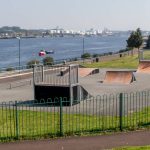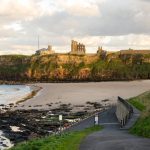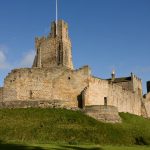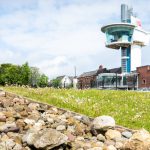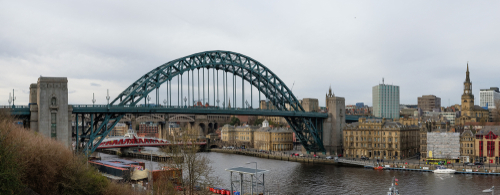
Newcastle upon Tyne (commonly known as Newcastle) is a city in the metropolitan county of Tyne and Wear, North-East England. It lies some 277 miles (446 km) north of London on the north bank of the River Tyne, about 8 miles (14 km) west of the North Sea. Newcastle is the most populous city in north-east England and forms the greater part of the Tyneside conurbation. It’s ranks 8th in the most densely populated urban areas in the UK. Newcastle is particularly noted for it’s long, proud industrial heritage, especially coal mining and shipbuilding.
The city has a strong local identity, with its citizens being referred to as ‘Geordies’ and the local dialect as ‘Geordie’ by the rest of the UK. Its people aside, Newcastle is arguably best known for the iconic Tyne Bridge, it’s eponymous Brown Ale, and it’s premier league football team, Newcastle United. The 2011 Census, saw the population of Newcastle, being recorded as 292,200.
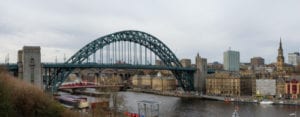
Image: John J Brown/Shutterstock,com
Newcastle A Fleeting History
The first recorded settlement in the Newcastle area was Pons Aelius (Hadrian’s Bridge), a Roman fort and River Tyne bridge crossing built in AD 122. It was given the family name of the ruling Roman Emperor Hadrian. The population of Pons Aelius in its heyday has been estimated at around 2,000. Pons Aelius was also a fortification on Hadrian’s Wall which ran from Wallsend on the east coast to Bowness on Solway, near Carlisle, on the west coast.
After the Roman departure from Britain in AD 410, Newcastle became part of the influential Anglo-Saxon kingdom of Northumbria. The settlement throughout this period was known as Monkchester. During the late 9th century, constant conflicts with the Danes left much of the settlement in ruins.
In 1080, recognising its strategic position, Robert Curthose, son of William the Conqueror, erected a wooden fort in the area. The town was then renamed, becoming known as Novum Castellum or New Castle. In 1087, the old wooden fort was replaced by a stone castle. However, just a year later there was a local rebellion against the Normans. The Norman army, led by Odo of Bayeux, William’s half-brother, sent to quell the uprising, left Newcastle close to ruins.
In 1172, the castle was restored under the reign of Henry II, who granted the town a charter. In 1174, the Scots king William the Lion was imprisoned in Newcastle Castle. During the 13th century, a 25 ft (7.6 m) high stone wall was built around the town to defend it against Scots invaders, signifying its growing importance. By the latter part of the 13th century, historical records show that shipbuilding, rope-making and the leather industries were already established in the town.
The Newcastle Coal Cartel
Throughout the 14th century, Newcastle was successfully defended against all attempted incursions by the Scots. In 1400, with a population of around 4,000, a large town at the time, Newcastle was created a county corporate by Henry IV.
In 1530, a royal act was introduced to the town that restricted all coal shipments from Tyneside to Newcastle Quayside, giving a monopoly in the coal trade to a cartel of Newcastle burgesses, known as the ‘Hostmen’. The monopoly lasted a considerable time, helping the local burgesses to prosper and develop the town. It was from these times that the phrase ‘like taking coals to Newcastle’ originated. The saying, meaning ‘a pointless pursuit’ is perhaps one of the county’s best-known idioms, and is still widely used today.
During the 1630’s, Newcastle was severely struck by the great plague, later named ‘the black death’. Later still, it was determined by historians that the plague was most likely ‘bubonic plague’, disease spread by black fleas. The outbreak is thought to have started in the deprived Sandgate area, just to the east of the city. The close-knit community of ‘Keelmen’ and their families, resided in the area in squalid conditions, next to the river. By the time it peaked in 1636, it’s estimated that 47% of Newcastle’s population of up to 20,000 were wiped out by the plague.
In 1642, came the English Civil War, between the king, Charles I, and parliament. Newcastle, like the rest of the North, sided with the king. In 1644, the Scots, allies of Cromwell’s parliamentary army, laid siege to the town, eventually forcing its surrender.
Prosperity Arrives
By the mid-1700s the population of Newcastle had risen to around 20,000. It was during the 18th century that private companies began providing piped water to the few well-to-do that could afford it. For the wealthy, life in Newcastle was becoming more comfortable and sophisticated, than ever before.
In the late 17th century, the town’s coal exports continued to boom along with the shipbuilding industry. Rope making also flourished, as did new industries such as lime, glass and salt production. It was then, that the renowned pioneering travel writer Celia Fiennes, described Newcastle Upon Tyne as a ‘noble town’ comparing it to London. ‘’The streets were broad, and the buildings were tall, and made of brick or stone’’.
By the early 18th century, an iron and steel industry along with clay pipe making had been established in the town. In 1751 an infirmary was opened, and the city’s first bank opened four years later. A customs house was built in 1766, and a dispensary where the poor could obtain free medicines opened in 1777.
In the later part of the 18th century, the urbanisation of Newcastle spread beyond the walls of the old town, as suburbs were created. Work had also begun on demolishing some of the town’s old walls and the gates since they impeded the flow of the increasing volumes of traffic. In 1781, a new bridge over the River Tyne was opened, replacing the old Medieval bridge that had been destroyed by a storm.
The Industrial Revolution Transforms Newcastle
Newcastle was viewed as a powerhouse of the Industrial Revolution, which saw the continued urbanisation of the town. In 1801, at the time of the first national census, Newcastle had a population of some 28,000. At this time, shipbuilding and heavy engineering were viewed as being central to the town’s continuing prosperity.
In 1829, ‘the Rocket’, manufactured by Robert Stephenson and Company in the town, won the famous Rainhill Trials, becoming the world’s fastest locomotive. Growing rapidly, by 1831 the population had reached 53,000. In 1835, the city boundaries were extended to include Byker, Westgate, Elswick, Jesmond and Heaton. The 2.5 miles (4 km) Victoria Tunnel was built in 1842, which provided underground access to the Staithes. By 1851, the population of the borough had reached over 87,000.
Beginning the installation in 1879, Newcastle was one of the first cities in the world to be lit by electric street lighting. Other major innovations coming out of the Newcastle area in the era, included George Stephenson’s miner’s safety lamp, William Armstrong’s hydraulic machinery and breech loading gun, Joseph Swan’s electric light bulbs, and Charles Parson’s steam turbine, which led to the revolution of marine propulsion and the production of cheap electricity. Status of ‘City’ was granted to Newcastle on 3 June 1882.
20th Century Newcastle
In 1901, Newcastle got its first taste of a modern public transport system when electric trams were introduced to the city’s streets. These were gradually replaced by trolley buses from 1935 onwards, with the tram service finally ending in 1950. With the advent of the motor car, the city’s road network also saw considerable improvement in the early 1900’s, beginning with the opening of the Redheugh road bridge in 1901, and later, the Tyne Bridge in 1928.
The city’s first art gallery, the Laing Art Gallery, named after its founder Alexander Laing, a Scottish wine and spirit merchant who had made his fortune in Newcastle, opened in 1904. The Hatton Gallery (now part of Newcastle University) opened in 1925. The Museum of Science and Industry and the John George Joicey Museum, both opened in 1934.
The 1920’s saw the first steps towards improvement of the city’s housing stock as new council houses began to replace inner city slums. However, the Great Depression arrived in 1929, changing everything. The North East was almost totally reliant on the coal, steel and shipbuilding industries.
The Depression caused a major collapse in demand for ships, such that between 1929 and 1932 production declined by 90%. This in turn affected its major supply industries, such as steel and coal. Unemployment in the city went on to hit record heights, reaching as much as 70% at its peak.
During WW2, Newcastle and the surrounding area was a target for German air raids because of its ship and armament industry. The raids caused 141 deaths and 587 injuries.
Modern Era Newcastle
After 1945, while manufacturing industries in the city contracted, new service industries grew. More and more people were becoming employed in public administration, retail and education. Newcastle University was founded in 1963, and Newcastle Polytechnic in 1969, becoming a university itself in 1992.
Meanwhile, the city’s heavy industries fell into terminal decline during the second half of the 20th Century. The last deep coal pit closed in 1956. WW2 brought about a brief revival to the shipbuilding industry, however by the 1960s and 70s, the Tyne shipyards were struggling again due to a lack of investment and increased global competition. The Lyme Bay, launched at Swan Hunter in September 2005, was the last ship built on the Tyne.
The city’s new Civic Centre and Central Library were completed in 1968, and likewise, Eldon Square Shopping Centre in 1976. Meanwhile, the building of council houses, which had begun in 1920s, continued up until the 1970s, along with substantial private house developments. The Newcastle Military Museum opened in 1983, likewise the Stephenson Railway Museum in 1986, a new Arts Centre in 1988 and the Monument Mall Shopping in 1992.
In the 21st century, Newcastle continues to thrive. The Life Science Centre opened in 2000 and the Millennium Bridge in 2001. In 2017, Newcastle staged the Freedom City festival, which commemorated the 50th anniversary of Dr Martin Luther King’s visit to the city. Throughout the summer of 2018, Newcastle hosted the Great Exhibition of the North. With numerous exhibits and displays spread over the city, the exhibition told the inspirational story of the north of England, through its locally born inventors, artists, designers and entrepreneurs.
Not A Lot Of People Know That
Newcastle is currently twinned with 9 cities throughout the world, has a ‘friendship agreement’ with Little Rock, USA and a ‘special cooperation agreement’ with Malmö, Sweden.
With a nod to its industrial heritage, Newcastle is now recognised as a city of culture. The city has plans to become the first ‘carbon neutral’ in the UK.
Getting there and around!
Road
It’s fairly easy to get to Newcastle from all parts of the country if you are travelling by car. The most direct and easiest way to get to Newcastle from London and the south, and Edinburgh and the east of Scotland, is via the A1. The A19 brings you north to the city from Sunderland, Middlesbrough and most of Yorkshire. The A69 is the principal road link from Carlisle and the north-west.
The A696/A68 passes the Airport, links Newcastle with central Northumberland and central Scottish Borders. Similarly, the A167, (formerly, the ‘Great North Road’) links Newcastle, to the south with Gateshead, Chester-le-Street, Durham and Darlington. The A1058 ‘Coast Road’, runs from Jesmond to the east coast, between Tynemouth and Cullercoats.
Rail
Newcastle’s main train station is one of the busiest in the UK and connects directly to almost all the country’s major destinations. The station is known as Newcastle Central Station and is a principal stop on the East Coast Main Line. Train operator London North Eastern Railway (LNER) provides a service to London’s King’s Cross. Trains run approximately every 30 minutes with a 3 hours journey time.
Most of the LNER trains also connect between Newcastle and Scotland, with all trains calling at Edinburgh Waverley. Several of the Edinburgh trains go on to connect with Glasgow Central, Aberdeen and Inverness. The Cross Country trains serve Newcastle from destinations in Yorkshire, the Midlands and the South West. Trans Pennine Express operates services from Newcastle to Manchester Airport and Liverpool Lime Street. Northern Rail provides local and regional services.
Metro
The Tyne & Wear Metro is a light rail system that serves much of the region. The Metro consists of two lines; the Green Line and the Yellow Line. The Green Line runs between Newcastle Airport and South Hylton, via Newcastle city centre, Gateshead and Sunderland. The Yellow Line runs between St James and South Shields, via North Shields, Tynemouth and Whitley Bay. It loops back through the city centre, and then runs due east to South Shields, via Gateshead and Jarrow.
Buses
The two main bus stations in Newcastle are at the Haymarket and Eldon Square. The three main operators that provide bus services in and around the city are Arriva North East; Go North East and Stagecoach North East. Arriva mainly operates from Haymarket bus station, providing services to the north of Newcastle, Northumberland and North Tyneside. Go-Ahead operates out of Eldon Square bus station, providing services south of the river to Gateshead, South Tyneside, Sunderland, and County Durham.
Stagecoach is the primary operator within the city, with cross-city services between east and west, via the city centre. They also provide some services to the Metro Centre, Killingworth, Wallsend and Ponteland.
Many bus routes pass Newcastle railway station, providing a link to rail and metro services. QuayLink is a bus service operating from the Quayside to destinations in the rest of Newcastle and Gateshead. Newcastle coach station, near the railway station, provides long-distance bus services to and from the rest of the country, operated by National Express.
Airport
Newcastle International Airport is located approximately 6 miles (10 km) from the city centre on its northern outskirts, near Ponteland. It is connected to the city via the Metro rail system. The journey time into the city centre via the Metro is approximately 20 minutes. There are numerous short-haul and long-haul flights to multiple destinations throughout Europe, Asia and the Americas.
Places to see!
A few recommendations of the many places to see in Newcastle are:
Tyne Bridge
There are seven bridges that span the River Tyne in and around Newcastle. While most of the structures are noteworthy, none can top the iconic Tyne Bridge. It undoubtedly symbolises Newcastle’s global identity more than anything else. Opened in 1928 by King George V, it was at that time, the largest single-arch bridge in the world.
The Quayside
The Quayside district of the Tyne around High-Level Bridge has been tastefully redeveloped, with many of the old houses being converted to hotels, shops, and restaurants. At Sandhill, there are several historic buildings, which include the Guildhall (1658) and Merchants’ Court. Bessie Surtees House consists of two merchant’s houses dating from the 16th and 17th centuries, which have been authentically restored with a Jacobean facade.
A popular tourist attraction is the 2.5-mile-long Victoria Tunnel, which runs beneath the city from Town Moor to the Tyne. The tunnel opened in 1842 as a wagonway to transport coal from the pit to riverside jetties. You can take a guided tour of the tunnel, but you will need to book in advance.
Newcastle Castle
North of High-Level Bridge on St. Nicholas Street, you will find the well-preserved Norman fortified tower of the original “New Castle”, which give rise to the city’s name. The castle construction began in 1080 and was completed in 1172. You can visit and explore the Norman Chapel, the King’s Chamber, and many old passages and chambers. There are several displays of artefacts and there’s an excellent view of the city from the tower. The gatehouse (the Black Gate) which was built in 1247, is located separately from the main site but is well worth exploring.
Grey’s Monument and Grainger Town
At Grey Street’s northern end stands the imposing Grey’s Monument. One hundred and thirty-five feet tall, the design is inspired by Nelson’s column. It was built in 1835, in memory of the second Earl Grey, it commemorates his role as Prime Minister and architect of the 1832 Reform Bill. The column has a viewing platform, which is a 164-step climb, but unfortunately only open to the public on special occasions. If you’re lucky enough to get the opportunity to make the climb, you’ll get a superb view of the city.
Grainger Street, which ends at Grey’s Monument, is one of Newcastle’s most attractive shopping streets. The thoroughfare and the area around it, Grainger Town, are named after Richard Grainger, the architect behind the rebuilding of the city centre between 1824 and 1841. The historic covered Grainger Market, selling foodstuff and jewellery, is a Grade I listed building, and well worth a look.
Things to do!
There are numerous things to do in and around Newcastle, a few suggestions are:
Museums and Galleries
If history and art is your thing, then you won’t find a much better place to visit than Newcastle. The city boasts quite a few museums and galleries. They include:
the Centre for Life with its Science Village,
the Discovery Museum, a museum detailing life on Tyneside through the ages, highlighting its shipbuilding heritage and regional inventions which changed the world;
the Great North Museum; the Seven Stories, a museum dedicated to children’s books;
the Great Northern Museum,
the Newburn Hall Motor Museum;
the Laing Art Gallery and the Hatton Gallery.
St James’ Park
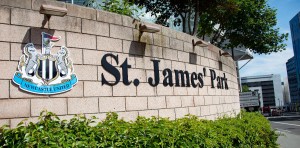
Image: TMA Harding/Shutterstock.com
Even those with minimal knowledge of football will know that the legendary St James’ Park is home to Newcastle United, who play in the English Premier League. It’s one of the most popular and visited attractions in the whole of the Tyneside area.
Football is almost a religion in Newcastle, with United fans being particularly renowned for their passion. Thus, there’s always a great atmosphere across the city on match days, so a day out at St. James’ is a must for any football enthusiasts.
If you can’t get to a match, you can take a behind the scenes tour of St James’ Park, allowing you access to the pitch, changing rooms and trophy room. It will also give you a chance to spot some of the local footballing heroes.
Shopping around Eldon Square
One of the best areas for shopping in the whole of the north is surely around Newcastle’s Eldon Square. The area comprises Eldon Square Shopping Centre, Eldon Garden, and the Central Arcade. Throughout the area, there are numerous walkways and arcades, which are lined with shops, designer boutiques, restaurants, bars, bistros and cafés.
Just to the west of Eldon Square is Chinatown, centred around Stowell Street, which is particularly renowned for its top-notch restaurants.
Cross all Seven Bridges
A bit of a challenge on foot but there are plenty of watering holes around!
Places to Stay In Newcastle
If you’re visiting Newcastle Upon Tyne for the first time, it’s probably best to stay around the city centre, preferably near Quayside. There’s plenty shops, restaurants, historic buildings and tourist attractions all within a short walking distance. Reasonable quality accommodation in and around Newcastle is relatively cheap. Indicative prices for the most popular types of available accommodation per night are as follows:
4 Star Hotel: £80 – £100 (2 people sharing)
Standard Hotel: £40 – £80 (2 people sharing)
Apartment: £100 – £150 (usually sleeping 4 – 6 people)
Hostel: £15 – £20 (dorm) £25 (single)
Try Our Newcastle Upon Tyne Quiz
Quiz Maker – powered by Riddle
So there you have it our Five Minute Overview of the fine city of Newcastle, and a quick quiz to see if you were paying attention! Before you go why not try some of our other quizzes or have a look at some of our other location guides. better still why not join our growing community it’s free and could be very rewarding going forward.

